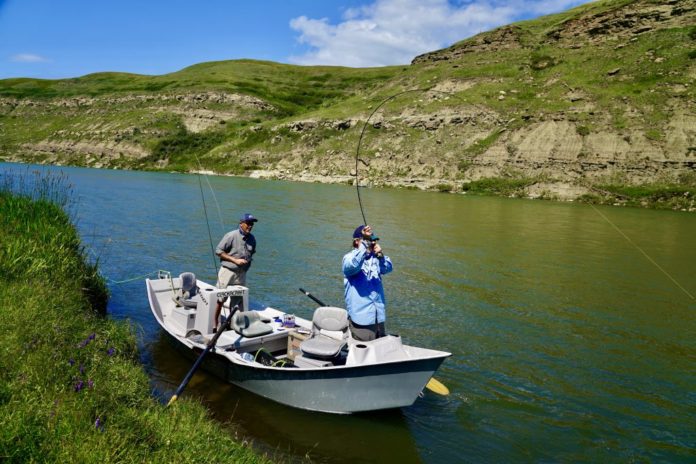The words “drift boat” cause most fly fishers to immediately go into daydream mode, fantasizing about big, trout-filled, Western rivers. A float trip is usually an all-day event in which a trio—two anglers and a rower–covers miles of river, all the while changing up techniques to adjust to what the trout want to eat. Fly-fishing from a drift boat is a great way to fish, and if you are a gearhead, the room for equipment and rod storage allows you to bring a bunch of unnecessary tackle along for the ride, which raises the excitement.
For anglers not accustomed to fishing from a drift boat, the experience can be somewhat intimidating. Here are a few points to help ensure that your first day in a drift boat is off to a good start.
1. Stand or Sit?

Whether you stand up or sit down while fishing from a Drift Boat will depend on a few things. Some anglers find it easier to cast while standing, because that’s what they’re accustomed to and it keeps the line high off the water. Standing is safe, provided that you are locked into the knee brace and your weight is centered in the boat. Staying locked in the knee braces prevents the angler from getting launched out of the boat if it hits a rock or there is a sudden shift in rowing. Anglers should also be aware of where the life jackets are, and if you are fishing high or rough water, consider wearing a PFD. Many anglers prefer standing while streamer fishing because it allows them to see fish chasing and flashing at the fly and have better line and casting control.
On flat tailwaters, such as the Missouri River or Alberta’s Oldman River, Guides often ask their clients sit down while fishing dry flies or nymphs. Both these rivers often feature strong and gusting winds, and a standing angler acts like a sail, making it more difficult to row the boat. Sitting down also lowers the anglers’ profile, giving wary fish less opportunity to get spooked. Seated anglers mean that the boat to get closer to the holding water and rising fish. Another reason to sit down is for safety, especially if you are going thru fast rapids or a tight channel.
2. Casting Rules

In order to avoid tangles, the front angler usually casts first, followed by the angler in the rear. It’s important that the angler in the stern watches the person in the bow and times their cast accordingly. Communication and coordination are key to avoiding crossing fly lines in the air. Some guides prefer using verbal cues, in which the front angler says “casting” to let the angler in the rear know.
Where to cast depends on where in the river. Generally speaking, anglers look downstream at the holding water or targets coming up, so they can be prepared to cast into or to whatever the target might be. If it’s a guided trip, the guide will tell you where he or she wants your fly to land. Take your time, as rushed casts generally end up as a mess. The key is to look ahead and plan your presentation to the target or holding water. Keep your casts overhead, as sidearm casting increases the chances that you hook your fishing partner or the Guide. Anglers need to be aware and in control of their casting.
3. Fish Fighting

The rule of thumb for that when one angler hooks up, the other reels in and takes a seat. This avoids tangles and other potential screw ups. Depending on the water and the size of the fish, the rower might net the fish while continuing to float or row to the bank and drop anchor. In fast currents, pulling over is safer for all in the boat, and if you’ve hooked into a monster, you can then fight the fish in slower water.
A drift boat is a great way to cover water, and the teamwork among the anglers and rower can be fun and exciting. By following these simple rules, you can ensure that everyone stays safe, and you have the best chance to hook and land more trout.
Dave Brown owns and operates Dave Brown Outfitters, which offers fly-fishing trips in Montana, Alberta, and British Columbia. They also offer guided bird hunts in Arizona, Montana, and Saskatchewan.
Credit: Source link






























